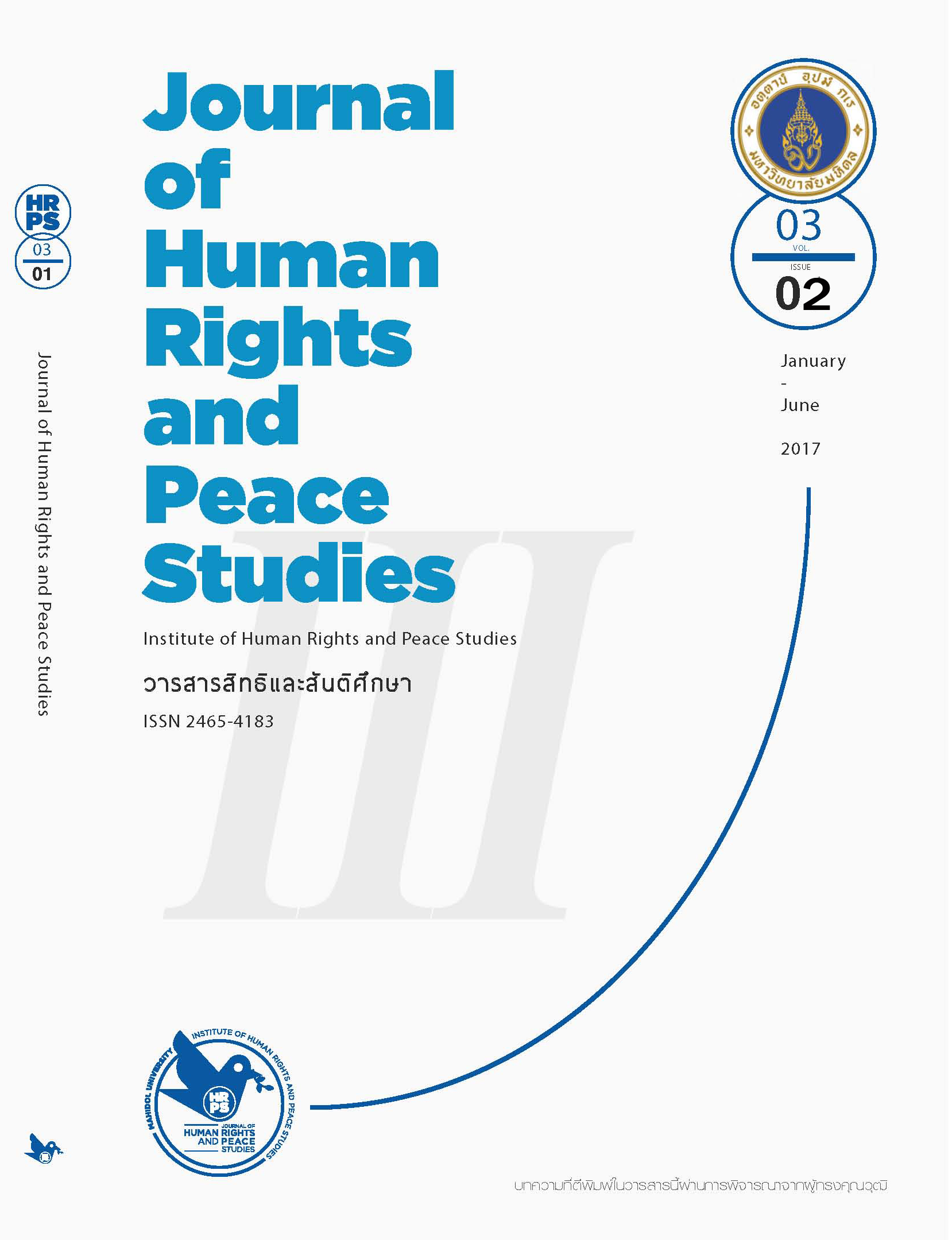Addressing Religion in Conflict: Insights from Myanmar
Main Article Content
Abstract
Peaceful coexistence between groups belonging to different religious traditions is under pressure in Myanmar today. Despite this, various peacebuilding initiatives aimed at addressing issues that involve interfaith or intercommunal relations and peaceful coexistence between religious communities in Myanmar exist. This article looks at what Myanmar and international peace practitioners and policy makers can learn from selected initiatives addressing intercommunal relations in Myanmar after the violent incidents of 2012. Key insights are drawn from three cae studies. First, is the insight that there are a diversity of approaches to address religion in conflict and it is important to match one’s approach according to what is driving the conflict, rather than using interfaith exchange as a panacea for religion in conflict. Second, the religious identity of peace practitioners impacts their scope of engagement, which makes working in religiously and culturally balanced teams, as well as working together with insider peacebuilders, all the more important. Third, religion can play the role of a divider and a connector across local, national, and international system boundaries. Even if a practitioner focuses on one arena, religion’s transboundary nature has implications for process design and needs to be dealt with consciousy.
Article Details
The views, opinions, and pictures expressed in this journal are those of the authors and do not necessarily reflect the opinions and viewpoints of the editor and the editorial board. All rights are reserved by the authors and the Institute of Human Rights and Peace Studies of Mahidol University. No part of this journal may be reproduced, stored in a retrieval system, or transmitted in any form or by any means without the prior permission in writing from the journal’s editor, or as expressly permitted by law, or under terms agreed with the appropriate reprographics rights organization. Non-commercial use of information in this journal must be properly referenced.
References
and Search for Common Ground. Effective Inter-religious
Action in Peacebuilding (EIAP) Program. Retrieved from
https://www.allianceforpeacebuilding.org/our-work/about-
our-work/peacebuilding-evaluation/effective-inter-religious-
action-in-peacebuilding/.
Berlie, J.A. (2008). The Burmanization of Myanmar’s Muslims.
Bangkok: While Lotus.
CDA Collaborative Learning (2002/2015). The Reflecting on Peace
Practice Program. Retrieved from https://cdacollaborative.
org/cdaproject/reflecting-on-peace-practice-project/.
Center for Diversity and National Harmony (2015). Rakhine State
Needs Assessment. Yangon, Myanmar: Center for Diversity
and National Harmony.
Center for Peace and Conflict Studies (2014). Portraits of
Diversity. Retrieved from https://www.youtube.com/
watch?v=f7Ho86Mzr4g.
Cheesman, N., & Farrelly, N. (eds.) (2016). Conflict in Myanmar:
War, Politics, Religion. Singapore: ISEAS Publishing.
Curle, A. (1971). Making Peace. London: Tavistock Press.
Dangerous Speech Project (2017). Retrieved from https://
dangerousspeech.org/myanmar/.
Gray, S., & Roos, J. (2014). Intercommunal Violence in Myanmar.
Risks and Opportunities for International Assistance.
Yangon: Adapt Research and Consulting & Mercy Corps.
Retrieved from https://www.mercycorps.org/sites/default/
files/Intercommunal%20Violence%20in%20Myanmar_
MercyCorps_Adapt_May%202014.pdf.
Institute for Global Engagement’s homepage. Retrieved from https://
globalengage.org/news-media/press-release/ige-expands-its-
religion-and-rule-of-law-training-program-in-myanmar.
Justice Trust Policy Report (2015). Hidden Hands Behind Communal
Violence in Myanmar: Case Study of the Mandalay Riots.
Justice Trust.
Khaminwa, A.N. (2003). Coexistence. Retrieved from https://www.
beyondintractability.org/essay/coexistence.
Kymlicka, W. (2001). Politics in the Vernacular: Nationalism,
Multiculturalism, and Citizenship. Oxford: Oxford University
Press.
Lederach, J.P. (2003). Conflict Transformation. Retrieved from
https://www.beyondintractability.org/essay/transformation.
Mercy Corps homepage. Retrieved from https://www.mercycorps.
org/about-us/our-work.
Mullen, M. (2016). Pathways That Changed Myanmar. London: Zed
Books, especially chapter 8 “From Human Rights Rhetoric
to 969” (pp. 193-205).
Panzagar’s Facebook account. Retrieved from https://www.facebook.
com/panzagar/.
Schissler, M., Walton, M.J., & Phyu Phyu Thi (2015). Threat and
Virtuous Defence: Listening to Narratives of Religious
Conflict in Six Myanmar Cities. M.MAS Working Paper 1:1.
St. Antony’s College, University of Oxford, and Myanmar
ICT for Development Organization.
Shwe Lu Maung. (2005). The Price of Silence: Muslim-Buddhist War
of Bangladesh and Myanmar. Columbia: DewDrop Arts &
Technology.
Sinh Nguyen Vo, D. (2008). Reconciliation and Conflict Tranformation.
Retrieved from https://www.beyondintractability.org/
casestudy/vo-reconciliation.
Spangler, B. (2017). Settlement, Resolution, Management, and
Transformation: An Explanation of Terms. Retrieved from
https://www.beyondintractability.org/essay/meaning_
resolution.
United Nations High Commissioner for Refugees (2013,
June 7). Retrieved from https://www.unhcr.org/news/
briefing/2013/6/51b1af0b6/year-displacement-rakhine-state-
myanmar.html.
Walton, M.J. (2016). Buddhism, Politics and Political Thought in
Myanmar. Cambridge: Cambridge University Press.
Walton, M.J., & Hayward, S. (2014). Contesting Buddhist Narratives:
Democratization, Nationalism, and Communal Violence in
Myanmar. Honolulu, Hawaii: East-West Center.
Woodhead, L. (2011). Five Concepts of Religion. International
Review of Sociology, 21(1), pp. 121-143.
Woodrow, P., Garred, M., with assistance from Chigas, D., Steele,
D., and Wilson-Grau, R. (2017). Effective Inter-religious
Action in Peacebuilding. Guide for Program Evaluation.
CDA-Alliance for Peacebuilding. Retrieved from https://
www.allianceforpeacebuilding.org/site/wp-content/
uploads/2017/04/EIAP-Guide-Pilot-Phase-Draft-03.08.17.
pdf.


